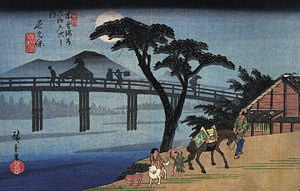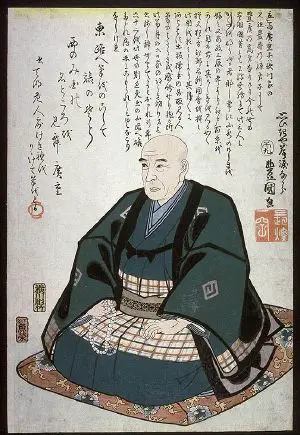Hiroshige
Utagawa Hiroshige, (IPA pronunciation: utɑgɑwɑ hɪˌrəʊʃi'geɪ, Japanese: 歌川広重; 1797 in Edo – October 12, 1858, also had the professional names "Andō Hiroshige" (安藤広重) (sometimes erroneously romanized as "Andro Hiroshige"[1]) and "Ichiyusai Hiroshige") was a Japanese ukiyo-e artist, and one of the last great artists in that tradition.
Early life
Hiroshige was born in 1797 and named "Andō Tokutarō" in the Yayosu barracks, just east of Edo Castle by the banks of the Yaesu River in the city of Edo (present-day Tokyo). His father was Andō Gen'emon, a hereditary retainer (of the dōshin rank) of the shōgun. An official within the fire-fighting organization whose duty was to protect Edo Castle from fire, Gen'emon and his family, along with 30 other samurai, lived within one of the ten barracks; although their salary of sixty koku marked them as a minor family, it was a stable position, and a very easy one- Professor Seiichiro Takahashi characterizes a fireman's duties as largely consisting of revelry [2]. The thirty samurai officials of a barracks, including Gen'emon, would oversee the efforts of the 300 lower-class workers who also lived within the barracks. A few scraps of evidence indicate he was tutored by another fireman who taught him in the Chinese-influenced Kanō school of painting.
Legend has it that Hiroshige determined to become a ukiyo-e artist when he saw the prints of his near-contemporary, Hokusai (Hokusai published some of his greatest prints, such as Thirty-six views of Mount Fuji, in 1832- the year Hiroshige devoted himself full-time to his art. From thence to Hokusai's death in 1849, their landscape works competed for the same customers). More likely though, like many other low-ranked samurai, Hiroshige's salary was insufficient for his needs, and this motivated him to look into artisanal crafts to supplement his income. It was easy to balance his job and his artistic pursuits as a fireman was only intermittently busy.
His natural inclination towards drawing (as a child, he had played with miniature landscapes, and he was already moderately well-known for a remarkably accomplished (for his age) painting in 1806 of a procession of delegates to the Shogun from the Ryukyu Islands) marked him for an artistic life. He began by being taught the Kano school's style by his friend, Okajima Rinsai. These studies (such as a study of perspective in the Dutch images imported) prepared him for an apprenticeship. He first attempted to enter the studio of the extremely successful Utagawa Toyokuni, but was rejected. Thus, he eventually embarked (he was rejected again upon his first attempt to enter Toyohiro's studio) upon an apprenticeship at the age of 15 in 1811 with the noted Utagawa Toyohiro instead of with Toyokuni; Toyohiro bestowed upon him the name "Utagawa" after only a year (apparently, artistic names would normally be granted after two or three years). Hiroshige would later take his master's name, becoming "Ichiyusai Hiroshige."
In his early apprenticeship to Toyohiro, he showed little sign of the artistic genius he would later be known for, and did not publish much; despite earning an artistic name ("Ichiyūsai Hiroshige") and school license at the young age of 15, Hiroshige's first genuinely original publications came only in 1818 (six years later; this was also the year he was commended for his heroism in fighting a fire at Ogawa-nichi) with his Eight Views of Lake Biwa and Ten Famous Places in the Eastern Capital. These were moderately successful, but his Famous Places in the Eastern Capital (1831) attracted his first real notice. It is speculated he wiled away the interim between his initial apprenticeship and 1818 engaging in work for Toyohiro's school, like painting fans and other small items- this sort of work would support him as he continued to study Kanō and Shijō painting styles. But all these were but precursors to the series of prints that made him famous. In 1832, Hiroshige was invited to join an embassy of Shogunal officials to the Imperial court; as his own son, Nakajiro, could handle Hiroshige's fireman duties, Hiroshige joined it, and carefully observed the Tōkaidō Road (or "Eastern Sea Route"), which wended its way along the shoreline, through a snowy mountain range, past Lake Biwa, and finally to Kyōto. His series would be called The Fifty-three Stations of the Tōkaidō. The series was a smashing success, and Hiroshige's career assured (though he would never live in much financial comfort, even in his old age).
In 1839, Hiroshige's first wife, a woman from the Okabe family, died. Hiroshige re-married, taking to wife O-yasu, daughter of a farmer named Kaemon
Hiroshige lived in the barracks until he turned 43 years of age. Gen'emon and his wife died in 1809, when Hiroshige was 12 years old, just a few months after his father passed the position onto him. He did not shirk his (admittedly light) duties as a fire-fighter, fulfilling them even after he had entered training in Utagawa Toyohiro's ukiyo-e school in 1811, and even when he had become an acclaimed wood-block print artist. He eventually turned his position over to Hiroshige III in 1832. Hiroshige II was a young print artist named Shigenobu, who married Hiroshige's daughter (either adoptive or from his second marriage), Tatsu; Hiroshige intended to make Shigenobu his heir in all matters, but Tatsu and Shigenobu separated. Shigenobu nevertheless began using the name Hiroshige and so is known as Hiroshige II. Tatsu remarried to another artist, named Shigemasa, who became Hiroshige's heir, as a fireman and in using his name; he is known as Hiroshige III. Neither II nor III were as good artists as was the original.
In his declining years, Hiroshige still produced thousands of prints to meet the demand for his works, but few were as good as those of his early and middle periods. In no small part, his prolificness stemmed from the fact that he was poorly paid per series, although he was still capable of remarkable art when the conditions were right- his great 100 Famous Views of Edo was paid for up front by a wealthy Buddhist priest in love with the publisher's (one Uoya Eikichi a successful fishmonger turned publisher), daughter.
In 1856, Hiroshige "retired from the world", becoming a Buddhist monk; this was the year he began his 100 Famous Views of Edo. He died aged 62 during the great Edo cholera epidemic of 1858 (whether the epidemic killed him is unknown) and was buried in a Zen Buddhist temple in Asakusa; just before his death, he left a poem:
- "I leave my brush in the East
- And set forth on my journey.
- I shall see the famous places in the Western Land."
(The Western Land in this sort of context refers to the strip of land by the Tokkaido between Kyoto and Edo, but it truly refers to the Paradise of the Amida Buddha).
Works

He largely confined himself to common ukiyo-e themes such as women (bijin-ga) and actors (yakushae); nor did he fully devote himself to his art. Only when he was 27 did he transfer the headship of his clan to his uncle. But Hiroshige made a dramatic turn about, when after 17 years, Toyohiro died, and Hiroshige came out with the landscape series Views of Edo (1831), which was critically acclaimed for its composition and colors. With Fifty-three Stations of the Tōkaidō (1833 – 1834), his success was assured; the prints, drawn from Hiroshige's actual travels of the full 490 kilometers, along with details of day, location, and anecdotes of his fellow travelers, were immensely popular. Hiroshige would go on to produce more than 2000 (of his estimated total 5000) different prints of the Edo and Tōkaidō Road areas, as well as fine series such as Sixty-nine Stations of the Kisokaidō (1834-1842).
He had little competition, dominating landscape prints with his unique brand of intimate, almost small-scale works (at least when compared against the older traditions of landscape painting descended from Chinese landscape painting through Sesshu). But as the years passed, Hiroshige determined to produce truly great art, and not the effortless works that characterized most of his work. In 1856, working with the publisher Uoya Eikichi, he determined to produce a series of prints of surpassing quality, made with the finest printing techniques including true gradation of color, the addition of mica to lend a unique iridescent effect, embossing, fabric printing, blind printing, and the use of glue printing (wherein ink is mixed with glue for a glittery effect). Hiroshige was now 60 years old, and had taken vows as a Buddhist monk. He was fully aware of his approaching death. 100 Famous Views of Edo (1856 – 1858) was immensely popular, and eventually reached a total of 118 printings, where Hiroshige had intended only about 100. In fact, not all of the prints were by him, as he died in 1858.
Influence
Hiroshige was the younger rival of Katsushika Hokusai. His series of prints Fifty-three Stations of the Tokaido (1833 – 1834) and 100 Famous Views of Edo (1856 – 1858) would greatly influence French impressionists like Monet and the Mir iskusstva (e.g., Ivan Bilibin); Vincent Van Gogh would copy two of the Hundred Famous Views of Edo.
See also
- 36 Views of Mount Fuji
ReferencesISBN links support NWE through referral fees
- ↑ See Introduction of D. Smith II; 1986
- ↑ "The firemen of his day appear to have actually spent most of their time gambling, drinking, or otherwise amusing themselves." pg 2 of Ando Hiroshige, authored by Professor Sei-ichiro Takahashi (head of the Japan Art Academy and Minister of Education in 1947), trans. by Charles S. Terry; published by the Charles E. Tuttle Company in 1956.
- Hiroshige: One Hundred Famous Views of Edo, paperback, 1986. D. Smith II, Henry; Poster, G Amy; Lehman, L. Arnold. Publisher: George Braziller Inc, plates from the Brooklyn Museum. ISBN 0-807-61143-3
- Ukiyo-e: 250 years of Japanese Art, hardcover, 1979. Toni Neuer, Herbert Libertson, Susugu Yoshida; W. H. Smith. ISBN 0-8317-9041-5
External links
- Article at Encyclopedia Britannica
- Ando Hiroshige- Free source of information and pictures
- Hiroshige at WebMuseum Paris
- Christian Science Monitor article
- Profile of Hiroshige
| Persondata | |
|---|---|
| NAME | Hiroshige, Utagawa |
| ALTERNATIVE NAMES | Hiroshige, Andō; Hiroshige, Andro; Hiroshige, Ichiyusai |
| SHORT DESCRIPTION | Major Japanese ukiyo-e woodblock print artist |
| DATE OF BIRTH | 1797 |
| PLACE OF BIRTH | Edo |
| DATE OF DEATH | October 12, 1858 |
| PLACE OF DEATH | Edo |
ar:هيروشيغه de:Hiroshige es:Hiroshige eo:Ando Hiroshige fr:Hiroshige it:Hiroshige ka:ანდო ჰიროშიგე nl:Ando Hiroshige ja:歌川広重 pl:Andou Hiroshige pt:Hiroshige uk:Утаґава Хіросіґе sv:Ando Hiroshige
Credits
New World Encyclopedia writers and editors rewrote and completed the Wikipedia article in accordance with New World Encyclopedia standards. This article abides by terms of the Creative Commons CC-by-sa 3.0 License (CC-by-sa), which may be used and disseminated with proper attribution. Credit is due under the terms of this license that can reference both the New World Encyclopedia contributors and the selfless volunteer contributors of the Wikimedia Foundation. To cite this article click here for a list of acceptable citing formats.The history of earlier contributions by wikipedians is accessible to researchers here:
The history of this article since it was imported to New World Encyclopedia:
Note: Some restrictions may apply to use of individual images which are separately licensed.

